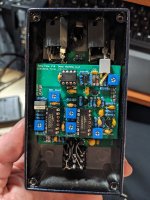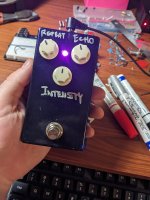MBFX
Well-known member
- Build Rating
- 5.00 star(s)
Behold, the Schu-Tone version of the DM-3! This bad boy can do 600ms of delay, boingy sproingy slapback, and everything in between.
The stacked boards work really well, and using tantalum capacitors made everything fit really well. I had to use a too-large film capacitor on the top board, though... ran out of the right MLCCs. Board layout is clean and sensible, with just enough room around the IC sockets. I used 1/4W resistors, and they work, but I'd probably buy 1/8W if I did it again.
This was a satisfying build. It sounds really good!Mine is a bit quiet, though - anyone else noticing some volume drop when engaged? I have a big bag of 4558s, should I try some others?
EDIT: The gain problem was caused by the Chanzon JRC4558 I used. IC1 needs a good-quality IC for the pedal to work. I used not that. I found a TL072 in my stash, dropped it in, and the problem was fixed. It sounds awesome (but brighter) with the TL072, so that seems to be a viable part substitution if need be! Clock noise is also gone, as having the right amount of gain at IC1 made biasing by ear easy. I look forward to reporting back when my shipment of nice Japanese 4558s comes in, and posting a demo video. Should I A/B the different ICs?
EDIT 2: I have somehow broken my footswitch. Don't do that
The stacked boards work really well, and using tantalum capacitors made everything fit really well. I had to use a too-large film capacitor on the top board, though... ran out of the right MLCCs. Board layout is clean and sensible, with just enough room around the IC sockets. I used 1/4W resistors, and they work, but I'd probably buy 1/8W if I did it again.
This was a satisfying build. It sounds really good!
EDIT: The gain problem was caused by the Chanzon JRC4558 I used. IC1 needs a good-quality IC for the pedal to work. I used not that. I found a TL072 in my stash, dropped it in, and the problem was fixed. It sounds awesome (but brighter) with the TL072, so that seems to be a viable part substitution if need be! Clock noise is also gone, as having the right amount of gain at IC1 made biasing by ear easy. I look forward to reporting back when my shipment of nice Japanese 4558s comes in, and posting a demo video. Should I A/B the different ICs?
EDIT 2: I have somehow broken my footswitch. Don't do that
Attachments
Last edited:




